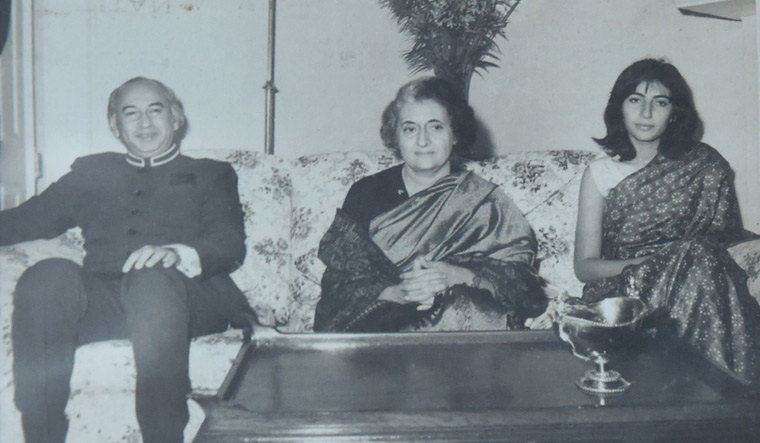Delhi, Shimla, Goa: Tale of 3 Bhuttos in India shows Pak's decline but not family's political spunk
Story highlights
Pakistan's 34-year-old foreign minister Bilawal Bhutto Zardari arrived in Goa this week for a meeting of the Shanghai Cooperation Organisation (SCO) and depending on how you read it, you can interpret the Namaste returned by the young Bhutto scion to his counterpart Subrahmanyam Jaishankar as a sign of diplomatic thaw, uneasy courtesy on a difficult encounter or persisting coldness between India and Pakistan.
A somewhat cold Namaste exchanged by two foreign ministers standing several feet apart, done in the beach state of Goa, brought back memories of three generations of one political family, across a troubled border.
Artful photographers use time-slice photography to show the passage of time in a single image. Time-slice photography captures motion, pace and atmosphere in a manner that shows a person, place or thing over minutes, time or even years. We cannot do that easily in news photography but a Tarot card-like reading of the image in Goa might help. Even better would be for us to recall some images and pages from the past to show how the times have changed and yet not.
trending now
Pakistan's 34-year-old foreign minister Bilawal Bhutto Zardari arrived in Goa this week for a meeting of the Shanghai Cooperation Organisation (SCO) and depending on how you read it, you can interpret the Namaste returned by the young Bhutto scion to his counterpart Subrahmanyam Jaishankar as a sign of diplomatic thaw, uneasy courtesy on a difficult encounter or persisting coldness between India and Pakistan.
Since its inception in 2001, the SCO has mostly talked about regional security and a fight against separatism and terrorism, often associated with religious extremism. But it is precisely these issues that have kept India and Pakistan apart for decades. After all, in the Indian political imagination, Pakistan itself seceded from undivided India in 1947 only to fan terrorism and separatism laced with religious extremism in the disputed Kashmir region.
There have been ups and downs since then, mostly downs.
We need to push the cameras of our minds back to 1964 when Prime Minister Jawaharlal Nehru died and Lal Bahadur Shastri took over. Bilawal's grandfather Zulfikar Ali Bhutto visited Delhi then as Pakistan's 36-year-old foreign minister to attend Nehru's funeral. The older Bhutto's American biographer Stanley Wolpert says that then-young Bhutto mistook the diminutive Shastri for a weakling and decided to push his country's military ruler Ayub Khan to invade Kashmir in 1965.
Pakistan lost the war badly. Bhutto resigned and rose in protest against the army ruler (much like Imran Khan did as PM recently) after joining the general in negotiating a peace treaty with Shastri, who died tragically and mysteriously in Tashkent where the treaty was signed. Uzbekistan is now part of the SCO, and memories of Tashkent come creeping in.
Watch | China issues report on US CIA's cyberattacks on other countries
Bhutto became prime minister after launching his socialist Pakistan People's Party (PPP) only to find India doing to East Pakistan in 1971 what he tried to do with Kashmir in 1965. The liberation of Bangladesh led to the Shimla Agreement between India and Pakistan in 1972. There is an enduring image of Indian Prime Minister Indira Gandhi and Bhutto shaking hands in Shimla that seems like a blurred memory of elusive peace.

Also in Shimla, we saw Benazir Bhutto, Zulfikar's daughter, still a teenager at 19, standing beside her father, and another one in which she is sitting beside Indira in a saree, a far cry from the Islamic rhetoric that Zulfikar Bhutto used to gain power in Pakistan.

The young Ms. Bhutto, Bilawal's mother, went on to become prime minister in PPP-led democratic governments as Pakistan shakily put army rule behind. Somewhere along the way, Zulfikar was hanged to death by the man he appointed as army chief, General Zia Ul Haq.
Why all this now? In time-slice terms, these images may show that Pakistan is a pale shadow of its former self as far as diplomatic and economic strengths go.
However, the young Bhutto, despite losing his grandfather to a military ruler's noose and his mother to a mysterious election rally assassination in 2007, retains the family spunk to show strength in times of severe adversity.
In 2016, he described Indian Prime Minister Narendra Modi as a "butcher" related to deaths in Gujarat and Kashmir and recently in March, raked up the Kashmir issue at the UN Security Council.
A Namaste in Goa cannot ease up relations between India and Pakistan any more than an elegantly worn saree did in Shimla in 1972. Pakistan's existential political weapons for mobilising mass support are Islam and Kashmir, and that does not appear to have changed despite Pakistan sinking deeply into an economic crisis.
We can always debate if demagogic politics is an escape from bad economics or if economic crises are caused by bad politics. Despite being liberals in their personal lives and amiable in their social behaviour, the Bhuttos have their political capital in the rhetoric that feeds Pakistan's masses. Unless that changes, little can be expected from the family that may still have the best interests of the average Pakistani in its hearts.
WATCH WION LIVE HERE
You can now write for wionews.com and be a part of the community. Share your stories and opinions with us here.


)
)
)
)
)
)
)
)
)
)
)
)
)
)
)
)